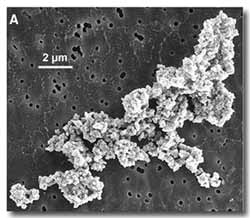This area deals with the fundamental laws and building blocks of nature and how they interact, the properties and the behavior of matter, and research into space and time and their structures.
innovations-report provides in-depth reports and articles on subjects such as astrophysics, laser technologies, nuclear, quantum, particle and solid-state physics, nanotechnologies, planetary research and findings (Mars, Venus) and developments related to the Hubble Telescope.

As big fish eat little fish in the Earth’s vast oceans, so too do supermassive black holes gorge on smaller black holes and neutron stars, making themselves more massive in the process. Using sophisticated computer modeling, Penn State scientists have calculated the rate of this black-hole snacking, called “extreme-mass-ratio inspirals.” They expect to see several events per year with the Laser Interferometer Space Antennae (LISA), a joint NASA – European Space Agency mission now in develop

Carbon and silicate grains in interplanetary dust particles are helping scientists solve a 40-year-old astronomical mystery.
Using a transmission electron microscope, researchers from Lawrence Livermore National Laboratory have detected a 5.7-electron volt or 2175 Å (angstrom) wavelength feature in interstellar grains that were embedded within interplanetary dust particles (IDPs). They found that this feature is carried by carbon and amorphous silicate grains that are abundant in

For the first time, astronomers have been able to combine the deepest optical images of the universe, obtained by the Hubble Space Telescope, with equally sharp images in the near-infrared part of the spectrum using a sophisticated new laser guide star system for adaptive optics at the W. M. Keck Observatory in Hawaii. The new observations, presented at the American Astronomical Society (AAS) meeting in San Diego this week, reveal unprecedented details of colliding galaxies with massive black hol

Professor Glennys R. Farrar, a physicist at New York University, today announced that, for the first time, a source of ultra-high energy cosmic rays has been isolated and studied, a major breakthrough in the field. Ultra-high energy cosmic rays–which rarely hit the earth–are believed to be the result of extremely powerful cosmic phenomena, such as the creation or accretion of massive black holes. In addition to elucidating the origin of these remarkable particles and the systems that crea

Observations eventually expected lead to increased understanding of interstellar dust and gas
Using NASA’s orbiting Far Ultraviolet Spectroscopic Explorer, a team of astronomers from The Johns Hopkins University and elsewhere has taken an unprecedented peek beneath the “skirts” of the tunic-clad Orion the Hunter and come away with observations that may lead to enhanced knowledge of how interstellar dust absorbs and scatters ultraviolet starlight. “Understanding interstellar dust i

Huge gas disk may be similar to stuff of early universe
An astronomer studying small irregular galaxies has discovered a remarkable feature in one of them that may provide key clues to understanding how galaxies form and the relationship between the gas and the stars within galaxies.
Liese van Zee of Indiana University Bloomington, using the National Science Foundation’s Very Large Array radio telescope in New Mexico, found that a small galaxy 16 million light-yea